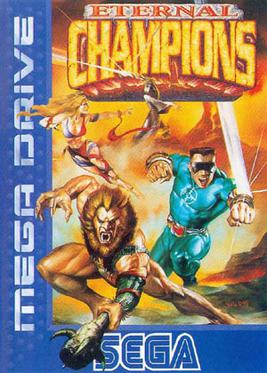
Eternal Champions is a 1993 fighting game developed and published by Sega for the Sega Genesis. It was one of the few fighting games of its time developed from the ground up as a home console title, rather than being released in arcades first and later ported to home systems.

Shinobi (忍) is a side-scrolling hack and slash video game produced by Sega, originally released for arcades on the Sega System 16 board in 1987. The player controls ninja Joe Musashi, to stop the Zeed terrorist organization from kidnapping students of his clan.
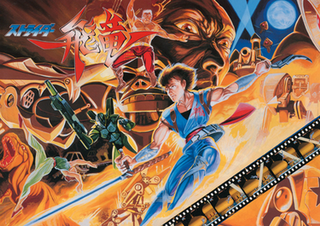
Strider, released in Japan as Strider Hiryū, is a 1989 hack and slash game developed and published by Capcom for arcades. Set in a dystopian future where Earth is ruled by the tyrannical Grandmaster Meio, it follows the titular Strider named Hiryu as he attempts to end his tyrannical reign for good. The game resulted from cooperation between Capcom and manga publisher Moto Kikaku. It marked the video game debut of Strider Hiryu, after the character was introduced in the 1988 manga Strider Hiryu.

Golden Axe is a 1989 hack and slash game developed and published by Sega for arcades, running on the Sega System 16B arcade hardware. Makoto Uchida was the lead designer of the game, and was also responsible for the creation of the previous year's Altered Beast. The game casts players as one of three warriors who must free the fantastical land of Yuria from the tyrannical rule of Death Adder, who wields the titular Golden Axe.

Primal Rage is a fighting game developed and released by Atari Games for arcades in 1994. The game takes place on a post-apocalyptic version of Earth called "Urth". Players control one of seven prehistoric beasts, that battle each other to determine the planet's fate. Matches feature many of the conventions of fighting games from the era, including special moves and gory finishing maneuvers. Ports were released for home video game consoles and personal computers. Efforts to perfectly emulate the arcade original have been unsuccessful due to the use of an unusual copy protection method. Toys, comics, a novel and other merchandise tie-ins were produced. More than 1.5 million copies of the game were sold.

Knights of the Round is an arcade game released by Capcom in 1991. A side-scrolling beat 'em up based loosely on the legend of King Arthur and the Knights of the Round Table, the game features an action role-playing video game-like level advancement system, with fighters automatically being upgraded to new weapons and armor as they advance through the game. An arcade edition of the game was included in Capcom Beat 'Em Up Bundle as one of seven titles released digitally for Nintendo Switch, PlayStation 4, Xbox One, and Windows in September 2018.

Midnight Resistance is a side-scrolling run and gun game produced by Data East and released in arcades in 1989. Midnight Resistance is set in a dystopian future where the player controls a member of a resistance movement who goes on a mission to rescue his kidnapped family from a drug kingpin.

Forgotten Worlds, titled Lost Worlds in Japan, is a side-scrolling shooter video game by Capcom, originally released as a coin-operated arcade game in 1988. It is notable for being the first title released by Capcom for their CP System arcade game hardware.

Captain Silver is a side-scrolling hack and slash platform game released as an arcade video game by Data East in 1987. Home versions were published for the Master System by Sega and for the Famicom by Tokuma Shoten.
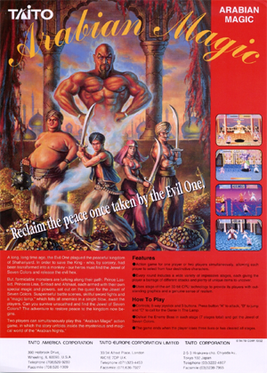
Arabian Magic is a side-scrolling hack-and-slash arcade video game developed by Taito and released in 1992. It was included in Taito Legends 2 for Microsoft Windows, PlayStation 2, and Xbox.

Astra Superstars (アストラスーパースターズ) is a 1998 arcade fighting game developed by Sunsoft and published by Tecmo. It was released in Japan on June 6, 1998. It is Sunsoft's fourth fighting game after the 1994 Super Famicom Hebereke franchise spin-off Sugoi Hebereke, the 1995 Galaxy Fight: Universal Warriors and the 1996 Waku Waku 7. It is powered by the Sega Saturn-based ST-V arcade system. Astra Superstars is an airborne-based fighting game.

Super Monaco GP is a Formula One racing simulation video game released by Sega, originally as a Sega X Board arcade game in 1989, followed by ports for multiple video game consoles and home computers in the early 1990s. It is the sequel to the 1979 arcade game Monaco GP. The arcade game consists of one race, the Monaco Grand Prix, but later ports added more courses and game modes based on the 1989 Formula One World Championship.

Atomic Runner Chelnov is a Japanese runner arcade video game developed and published by Data East in 1988.
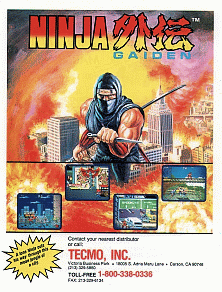
Ninja Gaiden, released in Japan as Ninja Ryūkenden and in Europe as Shadow Warriors, is a 1988 beat 'em up game developed and published by Tecmo as a coin-operated arcade video game. It was first released in North America and Europe in late 1988, and then in Japan in February 1989. It was the first game released in the Ninja Gaiden franchise. The arcade game was a major commercial success in North America, becoming the highest-grossing arcade conversion kit of 1989 in the United States.
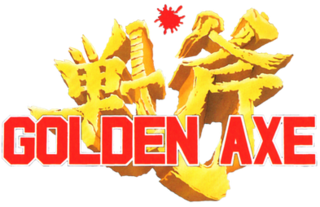
Golden Axe is a series of side-scrolling beat 'em up arcade video games developed by Sega. The series takes place in a medieval fantasy world where several heroes have the task of recovering the legendary Golden Axe, the mainstay element of the series.

Thunder Blade is a third-person shoot 'em up video game released by Sega for arcades in 1987. Players control a helicopter to destroy enemy vehicles. The game was released as a stand-up arcade cabinet with force feedback, as the joystick vibrates. A helicopter shaped sit-down model was released, replacing the force feedback with a cockpit seat that moves in tandem with the joystick. It is a motion simulator cabinet, like the previous Sega Super Scaler games Space Harrier (1985) and After Burner (1987). The game's plot and setting was inspired by the film Blue Thunder (1983).
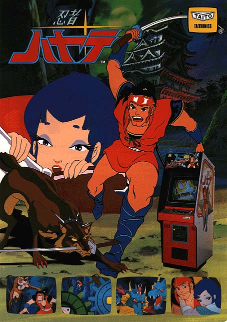
Ninja Hayate (忍者ハヤテ) is a 1984 laserdisc video game first developed and released by Taito and Malone Films for arcades in Japan and the United States. The game was later ported to the Sega CD video game console as Revenge of the Ninja in 1994.
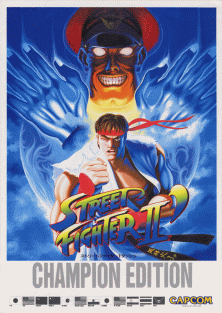
Street Fighter II: Champion Edition, released as Street Fighter II Dash in Japan, is a fighting game released by Capcom in 1992. It was launched for arcades and converted to several video game consoles. It is the first of several updated versions of Street Fighter II, and part of the Street Fighter series. The main changes are the addition of the four grand masters as playable characters and mirror matches. The fighting techniques of the eight main characters from the original game were further balanced for competitive play.

Rastan Saga, known as Rastan in North America, is a side-scrolling hack and slash arcade video game released by Taito in 1987. It was a critical and commercial success and was ported to home platforms. On May 2, 2024, the arcade version of the game got ported as part of the Arcade Archives series.



















